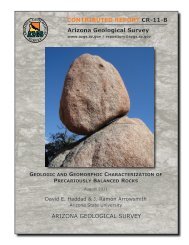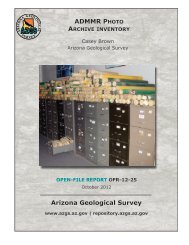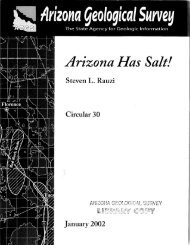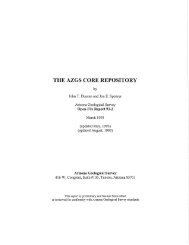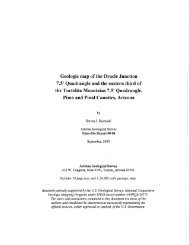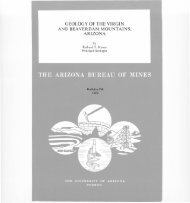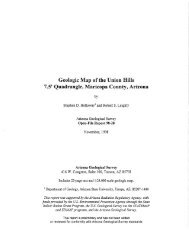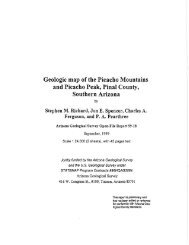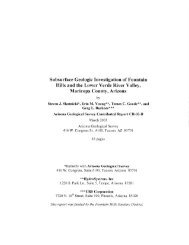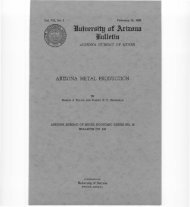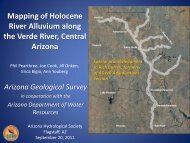ARIZONA MINING PERMITTING GUIDE - AZGS Document Repository
ARIZONA MINING PERMITTING GUIDE - AZGS Document Repository
ARIZONA MINING PERMITTING GUIDE - AZGS Document Repository
Create successful ePaper yourself
Turn your PDF publications into a flip-book with our unique Google optimized e-Paper software.
Above-Ground Fuel Storage - Continued<br />
Arizona Mining Permitting Guide<br />
SUPPORTS, FOUNDATIONS, AND ANCHORAGE:<br />
Tanks at grade shall rest on foundations made of concrete, masonry, piling or protected steel.<br />
(UFC 79.505, 29, C.F.R. 1910.106(b)(5)(i) and (iv))<br />
Tank foundations shall be designed to minimize corrosion and the possibility of uneven<br />
settling of the tank. (UFC 79.505)<br />
Tanks above grade shall be securely supported. Their foundations shall be of concrete,<br />
masonry or protected steel. (If steel is more than 12 inches high.) (UFC 79,505(b))<br />
Where a tank is located in an area that is subject to flooding, consult 29 C.F.R. 1910.106 (vi).<br />
In General, each horizontal tank so located that more than 70 percent of its storage capacity<br />
will be submerged during flood stage, shall be anchored, attached to a foundation of concrete<br />
or of steel and concrete of sufficient weight to provide adequate load for the tank when filled<br />
with flammable liquid and submerged by flood waters to the established flood stage, or<br />
adequately secured by other means. (29 C.F.R. 1910.106 (vi)(d)).<br />
DRAINAGE & DIKES FOR ABOVE-GROUND TANKS:<br />
The area surrounding a tank or group of tanks shall be provided with drainage or shall be<br />
diked to prevent accidental discharge of liquid from entering adjacent tanks, adjoining<br />
property or reaching water-ways. (UFC 79.507 (a))<br />
Drainage:<br />
Where protection of adjacent tanks, adjoining property or waterways is by means of a natural<br />
or man-made drainage system, such system shall comply with the following:<br />
Drainage shall be provided at a slope of not less than one percent away from the tank toward<br />
an impounding basin or an approved means of disposal having a capacity greater than that of<br />
the largest tank served. This termination area and the route of the drainage system shall be so<br />
located that a fire occurring in the drainage system will not seriously endanger tanks or<br />
adjoining property. (UFC 79.507 (b))<br />
Dikes:<br />
The volumetric capacity of the diked area shall be not less than the greatest amount of liquid<br />
that can be released from the largest tank within the diked area. The capacity of the diked area<br />
enclosing more than one tank, shall be calculated by deducting the volume of the tanks other<br />
than the largest tank below the height of the dike. (UFC 79.507 (c) (1))<br />
Walls of the diked area shall be of earth, steel, concrete, or solid masonry, all to be designed<br />
to be liquid tight and to withstand a full hydrostatic head. Earthen walls three feet or more in<br />
height shall have a flat section at the top of not less than two feet wide. The minimum<br />
distance between tank and toe of the interior dike walls shall be at least five feet. (UFC 79.507<br />
(c) (2))<br />
74



